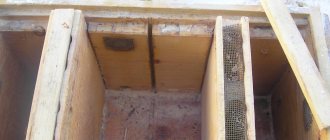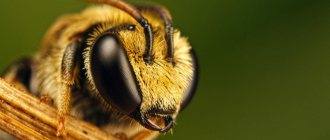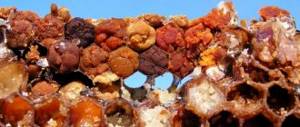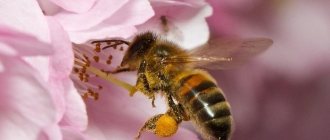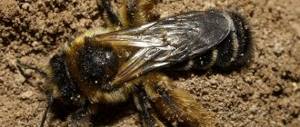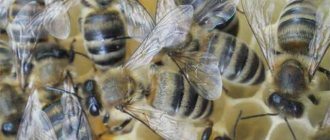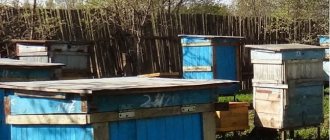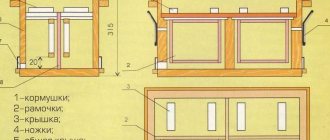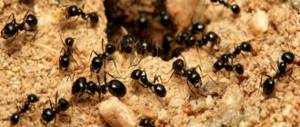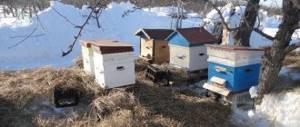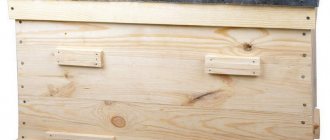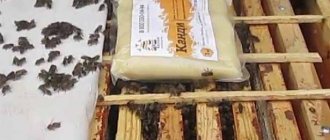Bee family composition
Fetal uterus
One of the entire family that can lay eggs (about several thousand per day). The “Queen” experiences the highest stress in the body. Therefore, she must eat frequently and plentifully. To do this, she is surrounded by nurses, about 15 bees. They feed the queen with special milk. Even in winter, nurses feed the queen with milk.
And if food supplies are insufficient, the queen is the last to die. The weight of the uterus ranges from 150-300 mg. The eggs form the larvae of worker bees and drones. Of the fertilized ones, there are worker bees, and of the unfertilized ones, there are drones. There are also cases of the birth of a new fetal uterus. The size of the queen bee is larger than that of ordinary bees.
Worker bees
Females cannot reproduce because they have a weak reproductive system. They settle honeycombs, store food for the winter, protect the hive from enemies and diseases, deliver nectar to the nest and form the basis of the bee family.
Drones
The males number a couple of hundred bees. They are needed in the nest for mating with the “queen”. A male bee weighs about 220 mg. Already on the eighth day after birth, the drone becomes a partner of the uterus. When the “queen” chooses a partner, the drones compete with each other for the opportunity to be with the queen.
This is how natural selection occurs, allowing the weakest to be removed, providing the uterus with strong partners for good offspring. After mating, the drone dies.
Interesting to know: If the queen is taken away from the bees, then after a few hours they begin to rush chaotically around the hive, as if they are in search of something valuable. And if you leave bees without a queen for a long time, the colony dies. If the queen gets into someone else's family, which already has its own queen, the bees can perceive her as an enemy and remove her from their territory by any means.
Therefore, the composition of the bee colony cannot change. Everything is interconnected and united.
See also
Types, structure, biology of the honey beeRead
Bee family: hierarchy, structure, distribution of responsibilities
A strong bee colony produces marketable honey and several layerings over the course of a season. They buy it for their apiary in the spring. By the time of purchase, at least a month must have passed from the flight. During this time, the process of changing bees takes place. Based on the state of the bee colony, it is easier to understand whether the queen is good or bad. You can keep 3 bee families on your summer cottage.
What is a “bee colony”?
In spring and summer, a bee colony should contain 1 fertile queen, from 20 to 80 thousand workers, 1-2 thousand drones and brood from 8 to 9 frames. There should be 12 frames in total. In beekeeping, buying a bee package is considered the simplest way to develop a bee colony. According to GOST 20728-75, it should include:
- bees – 1.2 kg;
- brood frames (300 mm) – at least 2 pcs.;
- queen bee – 1 pc.;
- feed – 3 kg;
- packaging for transportation.
How does a bee colony work?
For a full life and reproduction in the hive there must be a complete composition of the bee family. A novice beekeeper should have an idea of the structure of the bee colony and the functions of individuals. The queen reproduces offspring. Externally, it differs from other insects:
- the size of the body - its length can reach 30 mm;
- greater than that of working individuals, it depends on the breed, and can reach up to 300 mg;
- they do not have baskets on their paws in which workers collect pollen.
Queens have no wax glands, and their eyes are poorly developed. The life of the entire highly organized bee colony is built around the queen. Usually there is only one per hive (bee colony). There are many worker bees in bee colonies, numbering in the thousands. Many tasks related to the life support of the bee colony inside and outside the hive are carried out by them:
- build honeycombs;
- feed larvae, drones, queen;
- fly out to collect pollen and nectar;
- warm the frames with brood, maintain the desired air temperature in the hive;
- carry out cleaning of honeycomb cells.
Drones are obligatory members of the bee family. These insects are males, their role in the bee colony is one - fertilization of eggs, which occurs during their mating with the queen. Due to their purpose, they are visually different from the females living in the hive. The drone has no stinger and a small proboscis. It is impossible for them to collect pollen from a flower. The dimensions of the male are larger than those of working females:
- average drone weight – 260 mg;
- body size – 17 mm.
The drones find the female (queen) by the smell of the uterine substance (pheromone). They sense it from a great distance. The drones are fed by workers. Over the summer they eat almost 50 kg of honey. During summer cold snaps, they can warm the brood (eggs, larvae) inside the hive, gathering in groups near the cells.
How are responsibilities distributed between individuals in a bee colony?
In bee colonies, a strict hierarchy is observed. The work process, continuously flowing inside and outside the hive, is distributed strictly by age. Young bees, whose age does not exceed 10 days, bear all the family work on the hive:
- are engaged in preparing the vacated cells in the honeycombs for new clutches of eggs (cleaning, polishing);
- maintain the desired temperature of the brood, while they sit on the surface of the frames or slowly move along them.
Nurse bees look after the brood. Individuals enter this status after they have formed special glands that produce royal jelly. Feeding glands are located on the head. Bee bread is the raw material for the production of royal jelly. Her nurses consume large quantities.
The drones mate with the queen outside the hive. This process occurs during flight. About 2 weeks pass from the moment they emerge from the cell until the onset of puberty. During daylight hours, sexually mature drones fly out 3 times. The first time was in the middle of the day. The flight duration is short, approximately 30 minutes.
Important! A sign of an old queen is the presence of overwintering drones in the hive.
All worker bees are female. One young individual emerging from the cell weighs up to 100 mg, the body size is 12-13 mm. Due to the lack of developed genital organs, female workers cannot reproduce.
Life cycle of a worker bee
The lifespan of worker bees depends on the strength of the bee colony, weather conditions, and volume of honey. The first life cycle lasts 10 days. During this period of life, the young worker exists inside the hive and is classified as a hive bee. During this period of time, feed glands are formed in individuals.
The second life cycle occurs over the next 10 days. It begins on the 10th day of a bee’s life and ends on the 20th. During this period, wax glands form in the abdomen and reach their maximum size. At the same time, the feed glands stop functioning. The individual turns from a nurse into a builder, cleaner, and protector.
The third cycle is the final one. It begins on the 20th day and lasts until the death of the worker. The wax glands stop functioning. Adult female workers are turning into assemblers. They leave household chores to the young insects. If the weather is favorable, the pickers fly out to collect the bribe.
Hive and flying worker bees
A strict hierarchy is observed in every bee colony. It is based on the physiological state of worker bees and is determined by their age. According to this hierarchy, all employees are divided into 2 groups:
- hive (40%);
- flying (60%).
The age of most non-flying individuals is 14-20 days, the older ones are included in the group of flying bees. Hive worker bees make short flights for 3-5 days, during which they cleanse the intestines through defecation.
The role of the worker bee
Having reached 3 days of age, young worker bees eat, rest and take part in caring for the brood. At this time, they warm the brood with their bodies. Growing up, the worker becomes a cleaner.
The queen can lay eggs in clean, prepared cells. Maintenance of vacated honeycombs is the responsibility of the cleaners. She is responsible for a number of cell maintenance tasks:
- cleaning;
- polishing with propolis;
- wetting with saliva.
Cleaners take out dead insects, moldy beebread, and other waste. From the 12th to the 18th day of life, the working individual of the bee colony becomes a nurse and a builder. The nurse bee should be close to the brood. She provides food for family members. The lives of larvae, queens, drones, and young bees that have just hatched from sealed cells depend on nurses.
The duties of hive bees include:
- production of honey from nectar;
- removing excess moisture from nectar;
- filling honeycombs with honey;
- sealing the cells with wax.
For most of their short lives as part of a bee colony, worker bees collect nectar and pollen. The individual becomes a forager after reaching the age of 15-20 days.
How bee brood is formed
In beekeeping, brood is understood as a collection of eggs, larvae, and pupae. Bees hatch from them after a certain period of time. The establishment (reproduction) of bee colonies occurs in spring and summer. From the eggs that the queen laid in the cell of the honeycomb, larvae hatch on the 3rd day.
They feed heavily for 6 days. In a short period of time, the mass of each increases 500 times. When the larva reaches the required size, they stop feeding it. The entrance to the worker's cell of the bee colony is sealed with wax.
A certain number of days pass before it becomes a full-fledged adult insect. The sealed pupa spins a cocoon around itself. The pupal stage lasts:
- for drones – 14 days;
- it takes 12 days to form worker bees;
- 9 days pass before the uterus appears.
| Brood type | Description |
| Seeding | Eggs lie in open cells of honeycombs |
| Cherva | Larvae live in open cells of honeycombs |
| Open | Open cells contain eggs and larvae |
| Printed | The cells are sealed with wax and contain pupae. |
Number of bees in a hive depending on the season
The strength of a bee colony is determined by the number of frames covered by bees. Frames with side dimensions of 300 x 435 mm can accommodate 250 insects. Classification of a bee colony during a bribe:
- strong – 6 kg or more;
- average – 4-5 kg;
- weak –
In a strong hive during honey harvest, the number of bee colonies is 60-80 thousand working individuals, in winter it decreases to 20-30 thousand. Pros of a strong family:
- a large number of flying individuals supplying nectar;
- Honey ripening occurs faster;
- flying individuals in bee colonies live longer, as they wear out less.
How long does a bee live?
The life expectancy of honey bees depends on the time of birth (spring, summer, autumn), the size of the brood, the intensity of daily work, diseases, weather, and the amount of food. The breed of the bee colony plays a significant role.
Bee colonies of the Central Russian breed are considered the most productive, hardy, and resistant to infections. Individuals of this species withstand a long winter (7-8 months). The Ukrainian steppe variety is resistant to low temperatures.
Bee colonies of the Krajina breed easily adapt to harsh conditions. In the harsh Russian climate, the Carpathian breed winters well. In the south of the country, Buckfast and Caucasian varieties are popular.
For a bee colony of any breed, it is necessary to create favorable conditions:
- hive of optimal size;
- warm winter;
- leave enough food in the hives;
- take the apiary to a good place where there are many honey plants.
How long does a worker bee live?
The lifespan of worker bees determines the time of their emergence. Insects born into a bee colony in spring and summer do not live long. From their exit from the cell to death, it takes at most 4-5 weeks. Forager bees live up to 40 days in a strong bee colony, and only 25 days in a weak one. There are many dangers along their life path. Warm weather extends lifespan.
Individuals that appear in the bee colony towards the end of August or in the autumn live longer. They are called winter bees, their lifespan is calculated in months. In autumn they feed on reserves and pollen.
There is no brood in the bee colony in winter. In winter, worker bees eat normally and lead a quiet, contemplative life. By spring, when the eggs appear, they retain the fat body and perform the work of nurse bees in the bee colony. They do not live to see the summer and die out gradually.
How long does a queen bee live?
Without a queen, a full life in a bee colony is impossible. Its lifespan is longer than that of drones and worker bees. Physiologically, she can mate and lay clutches for 4-5 years. Long-lived bees are found in strong bee colonies. The queen remains productive for a long time if she is well protected and fed abundantly.
Most often, queens live in a bee colony for 2-3 years. After this time, the mother’s body is exhausted due to the large number of clutches. When productivity drops and the number of eggs laid decreases, the bee colony replaces the queen with a younger individual. The queen of the hive, removed from allowance, lives less than 5 years.
How long does a drone live?
In bee colonies, drones hatch closer to summer. Having reached the age of 2 weeks, they are ready to perform their function - to fertilize the uterus. The lucky ones who gain access to the queen's body die immediately after the sperm are released.
Attention! The drone lives in the bee colony from May to August, and during this time it eats 4 times more than the worker.
Some of them die during the fight with other drones for the queen. The surviving males of the bee colony continue to live in the hive for some time, fully provided for. They are fed by nurse bees. When the honey collection period comes to an end, the drones are expelled from the hive. In bee colonies where the queen has died or become infertile, a certain number of drones are left behind.
Collapse of bee colonies: causes
Beekeepers first recorded a new disease in 2016. Bee families began to disappear from the hives. They called it KPS - bee colony collapse. With CPS, a complete flight of bees is observed. The brood and food remain in the hive. There are no dead bees in it. In rare cases, a queen and a few workers are found in the hive.
The reason for the autumn gathering of a bee colony can be various factors:
- long, warm autumn, the presence of bribes in September;
- a large number of bee families in the wintering area;
- reducing the size of the nest in preparation for winter;
- varroa mite.
This is a list of possible reasons for the gathering of bee colonies; even scientists do not have exact data. According to many beekeepers, the main reason for the death of bee colonies is mites and the lack of timely anti-mite treatment. It is believed that insects in the bee colony are influenced by new generation mobile communications (3G, 4G).
Conclusion
A strong bee colony is characterized by high productivity, strong offspring, and longer life expectancy. They spend less effort and money on its maintenance than on a weak bee colony. The guarantee of a strong bee colony is a productive young queen, sufficient food supplies, a warm hive, well stocked with honeycombs.
Source: https://fermilon.ru/hozyajstvo/pchelovodstvo/sostav-i-zhizn-pchelinoy-semi.html
Features of the bee family
Each individual bee colony has its own unique characteristics. For example, the pheromones that a queen secretes are unique to her and do not smell like the pheromones of other queens.
Interesting to know: Bees from the same family distinguish their own by smell and quickly identify strangers, actively protecting the hive.
Also, each bee colony, in addition to smell, has the following distinctive features:
- performance during honey collection;
- the amount of wax that the bee secretes;
- ability to reproduce;
- resistance to various diseases;
- aggressive behavior.
Interesting to know: Bees live in sterile cleanliness! However, if nectar, pollen, and water are introduced into the hive, then a huge number of microorganisms also enter with them. The bees are trying to eliminate the infection. They secrete a special antibiotic and neutralize the home from fungi, etc.
Therefore, the inside is always clean, it smells pleasant, the walls of the nest are covered with a layer of propolis.
Worker bees
We recommend reading our other articles
- Winter varieties of apple trees
- Description of the cucumber variety Adam F1
- Description of Saanen goats
- Chinese silk chicken - characteristics of the breed
All worker bees in the hive are female. There are about 90 thousand of them in the hive during honey harvest and about 40 thousand from late autumn to early spring. Their genitals are underdeveloped due to the pheromone secreted by the uterus, so they cannot lay eggs. What are their functions? Worker bees perform a lot of important tasks, namely:
All worker bees in the hive are female
- looking for melliferous crops;
- collect pollen;
- take care of the larvae;
- monitor the condition of the hive (clean, patch holes, etc.);
- maintain normal humidity in the hive;
- make honeycombs;
- warm and protect the hive.
Depending on their age, worker bees have different jobs. For example, old bees work all the time outside the hive, and young bees work in 2 shifts inside the nest. One group works at night, the other during the day. They do good internal work and protect the “home”.
Interesting!
Bees are very irritated by the smell of animals, sweat, alcohol, and cologne.
The relationship of bees in a family
Scientists believe that there is no leader in a bee family and their interaction is based only on instincts. They interact using smell, sound, tactile contacts, as well as special signals called “bee dances.”
All individuals of a bee family are subject to certain interconnected processes. For example, the feed processing process. Bees regularly transfer food to other bees, the queen, and larvae. Therefore, the nest contains food of the same composition.
It is interesting to know: through their active work, bees maintain the required temperature in the nest - thirty-five degrees, as well as the level of humidity. This is necessary to maintain the livelihoods of all family members.
Bees communicate with each other. For example, “scout girls”, arriving at the hive, begin to dance in a peculiar way, and the more intense their movements, the greater the source of honey collection they discovered.
When building honeycombs, in the structure of the honeycombs themselves, each bee colony lays its own unique matrix as the basis, which is not similar to the matrices of other families. Some scientists believe that honeycombs can be used to trace the genetic inheritance of an individual family of bees.
See also
Types, structure, biology of the honey beeRead
Functions of bees in a family
The life of a bee family is subject to immutable laws. Each has its own distinct function. Neither drones, nor worker bees, nor the queen can reproduce and coexist without each other. Development of the worker bee:
- 1-3 days of a bee's existence. They monitor the conditions in the cells, learn;
- 4 days. Bees feed those larvae that are older than the rest;
- 7 days. The bees help feed the queen and care for the new larvae;
- 12-18 days. The bee develops wax glands. She is already able to build honeycombs herself and receive nectar from other bees. Therefore, bees of this age take nectar and form it into honeycombs;
- 21 days or more. Bees are ready to collect nectar and pollen.
The development of the drone and the queen is similar to the development of a working queen. However, the difference is that the queen larva becomes a pupa five days faster, unlike the worker bee. And the drone, on the contrary, is five days later.
Each individual of the bee family has its own occupation: one gets food, the second protects the house from strangers, the third participates in reproduction, the fourth reproduces, etc. Bees work for the benefit of the whole family. The collective existence of bees ensures the existence of their family with virtually no time limit.
When some bees die off, new ones are born in their place. This is how the life of the bee colony continues. Only by working together can bees collect the required amount of food, stock up on food for the winter, and protect the nest from the enemy.
Interesting to know: A bee cannot survive alone. Even if she remains warm and eating, the bee still dies after a couple of hours. And if bees of other individuals are encountered on the way, a single bee joins them.
The biology of a bee family is structured in such a way that the existence of bees can only occur in conditions of the joint interrelation of all individuals.
Life of bees
A bee is a beneficial insect that produces valuable products, such as honey. Insects have spread throughout the Earth. They evolve together with honey plants. Their body consists of three sections: head, chest and abdomen.
How does a worker bee create honey or build honeycombs? Bee products were closely related to each other. To obtain a kilogram of honey, an insect must collect nectar from three million flowers. People are not even aware of the complexity of the process and how it happens.
Let's see how a family of bees works, in which everything is clearly coordinated and everyone has their own job. Who is in the family? Of course, the queen and the drone and, of course, the bees. They are honey-bearing and working.
The queen is the head of the family. She is engaged in the reproduction of offspring. It is easy to recognize, it is large in size. The fetal uterus can secrete uterine substance. It contains a lipid complex. The barren one has pheromones that are released during the nuptial flight. Drones are male and fertilize the queen. There is nothing more to their role.
The plants have bloomed, workers fly to them to collect juice, using their proboscis. An insect, sitting on a flower, using its taste buds located on its legs, tries to understand whether there is an odorous substance on the plant. If there is a substance, it collects it into the second stomach it has, intended for nectar. About 60 ml of odorous liquid is placed in this stomach. This is how much an insect can carry away in its honey “crop.”
Future honey is brought by a bee and transferred to another bee that is in the hive. After this, the processing process will begin. Honey is formed from nectar after water evaporates. This is done by distilling nectar from one cell to another.
Honey is a sticky mass produced by insects that contains enzymes. He joins the honeycomb.
Honeycomb is a specially created structure that contains wax. A family of bees lives in them, feeds and raises offspring.
The insect uses wax to build honeycombs. This bee product is produced by them at the level of instincts. If there is nowhere else to store nectar, then the individual begins to produce wax instead of honey, using wax glands.
Cells are built in a chain by connecting to each other. At the end of the row the wax is transferred. It is transformed into a hexagonal shape with the help of construction bees and their mandibles.
Insects do not just produce honeycombs; they make them when they need to produce nectar in reserve. For bee productivity to develop, there must be empty cells. When taking honey from bees, remember this. Honey raw materials have filled the cells by a quarter; ventilation is required. Insects do it themselves with the help of their wings. If you stand outside the hive you can hear a strong buzzing sound. Sealing with timber occurs at the moment when humidity drops to 20%!
A friendly hive implies strict sanitation, so all unnecessary items are thrown away by individuals. If there are excess substances, the created product may ferment. Therefore, insects carry the honeycombs to the top of the hive and pack them tightly.
In winter, the resulting product is food for larvae and insects.
This species does not live long. Their life depends on a large number of factors. A lot of energy is spent collecting pollen, making food, and breeding bees. Due to their short lifespan, they have to continuously lay larvae. At the moment when the peak of growth occurs, 2 thousand brood broods can appear per day.
Speaking of bees, let's see how long each species of bee lives?
How long does a worker bee live? Climatic conditions greatly influence the lifespan of this species. If the family is strong, then the lifespan is 36 days. In the weaker family, this period is 26 days. The duration in summer can increase to 45 days. The life of an insect increases in the summer, due to the fact that they feel much more comfortable. Once an insect has overwintered, it can only live for 30 days.
Keeping Bees for Beginners: Tips and Tricks
If the brood of bees, in winter and summer, is not raised by insects, then they can live up to 2 months. This only happens when in the fall it turns out to feed a lot of brood. If an insect spends a lot of energy, its lifespan decreases. The family begins to slow down its growth in late spring, so its lifespan increases.
Queen bee
The queen of the hive leads a quiet life. She doesn't collect honey or look for pollen, so she doesn't spend a lot of energy. The time has come to lay bee larvae, the queen begins to feed intensively. Milk is included in the food of the uterus, thanks to this product its functions are restored faster. Every type of bee takes care of the queen, which is why she lives a long time. Its lifespan is approximately 5 years.
A queen in a strong colony can lay many eggs. She begins to age faster and can live for 2 years. When the queen of the hive dies, she is replaced with a new one.
Workers can affect the lifespan of the queen. If she can't cope with her responsibilities, they remove her.
Worker bees and drones live the same amount of time. Drones can live in the hive during the summer. After which the bees in the hive expel him.
Drone
In the summer, the insect works and sees virtually no rest. It is known what they do in the summer. Do you know about bees in winter? What are they doing? Some might think that they hibernate, but this assumption is incorrect. They begin to save their energy by slowing down their metabolism. So, they can eat less food.
Any type of bee does not hibernate. They warm each other by creating a tight ball. In the fall, they assemble a nest so that they do not freeze in winter, even in extreme cold. Because bees are less active, they can survive the winter with their energy conserved.
What is the peculiarity of a ball of bees:
- When an insect prepares for winter, they think about reserves and how to properly distribute them so that they can be conveniently taken in the future.
- Insects spend the winter on a winter bed, which stands in the center of their home. They place the food on top.
- To create a bee ball, individuals create a dense ball. They warm each other and maintain a constant temperature in the house.
- If the temperature begins to drop in winter, the ball of bees shrinks tighter.
Germs
This species of individuals reproduces using separate processes. Having met away from the apiary, mating of the queen and drone occurs during the flight. This mainly occurs at temperatures above 25C. The drone does not survive after mating. The thing is that after mating, his genitals remain in the uterus.
Once the queen has mated, she begins laying eggs around the third day. A small number of eggs are laid by young queens. Eggs can be fertilized or unfertilized. Young drones emerge from an unfertilized egg. The development of the bee and queen occurs from a fertilized egg.
Then the bee larvae begin to be supplied with food. The insect seals the cells where the larvae are located. This is where the weaving of the cocoon takes place. Thus, the prepupa stage begins, and then the pupal stage, in which the organs of the larva are replaced with new ones. Subsequently, new young individuals emerge from the pupa.
Varroatosis of bees: treatment with folk remedies and treatment with drugs
In bees, the tyrant of the hive is the bees guarding the queen. They can force the queen to lay more eggs. If the uterus does not suit them, they can simply replace it with a new one. This mainly happens at the moment of poor performance of one's duties, as mentioned above.
Now you know everything about bees. Each knowledge gained can be applied in practice to the benefit of the beekeeper. By applying this knowledge, you will receive a different finished product that is beneficial for bees. This should not be forgotten.
Author: Barantseva Oksana
Similar articles
How does the time of year affect the number of bees in a hive?
The bee family goes through several stages of its development. The year can be divided into two stages, two stages:
- Reproduction stage. When bees awaken after winter and begin to reproduce and regain their former power. They lose about 30,000 bees over the winter.
- Self-preservation stage. Occurs during late autumn. Bees slow down their activity.
See also
Types, structure, biology of the honey beeRead
How many bees are in the hive? In the summer, the average bee colony has a single queen and 60,000-80,000 worker bees and several thousand drones. When the family reaches a certain number of individuals, they divide and begin to work actively.
The bees work diligently, collecting nectar. Drones are bred specifically to inseminate the queen during the summer. In autumn there is no need for drones, so the bees drive them out of the hive.
Before the honey harvest, the number of bees can reach one hundred thousand individuals. In winter, the bee family becomes quiet in the nest and life slows down sharply. During the winter period, approximately thirty thousand bees leave. The smallest number of bees occurs in the spring. Then they gradually increase, by the end of April there are approximately 30% of young bees in the hive, and by May the family is completely renewed.
Interesting to know: drones are temporary (seasonal) family members. By autumn they die.
How long do bees live?
The uterus is the only long-lived one and lives for about four years. The drones die either after they have impregnated the female, or after they are driven out of the hive in the fall. True, there are those males who are left to overwinter in the hive. But this rarely happens, only when the “queen” is not fertilized.
Interesting to know: On average, a worker bee lives 1 month during the honey collection period. And in early autumn, bees live up to three months. This longevity is associated with good nutrition and a quiet lifestyle.
